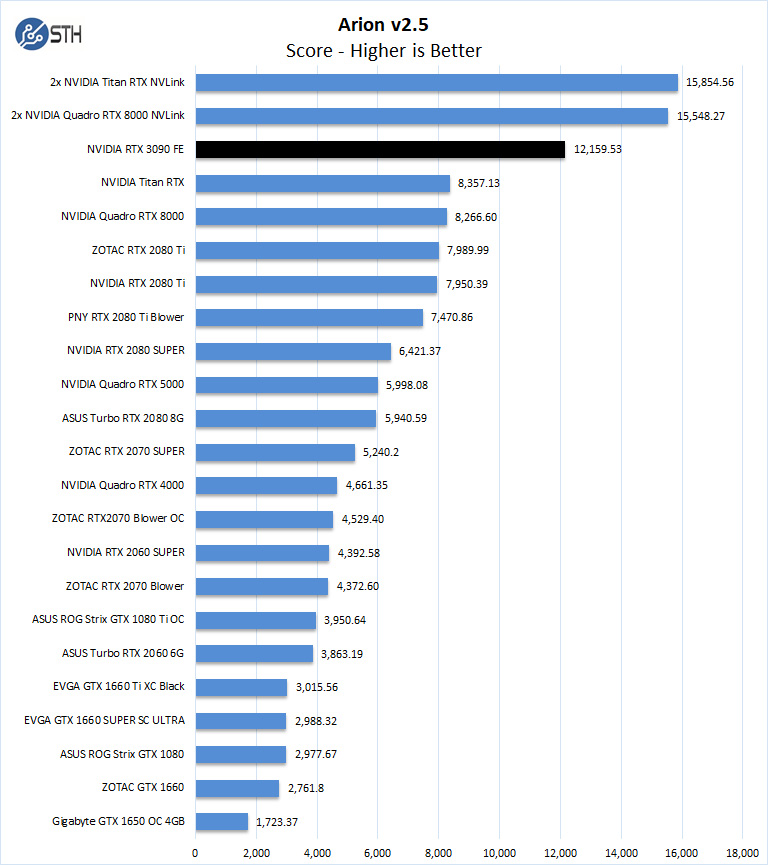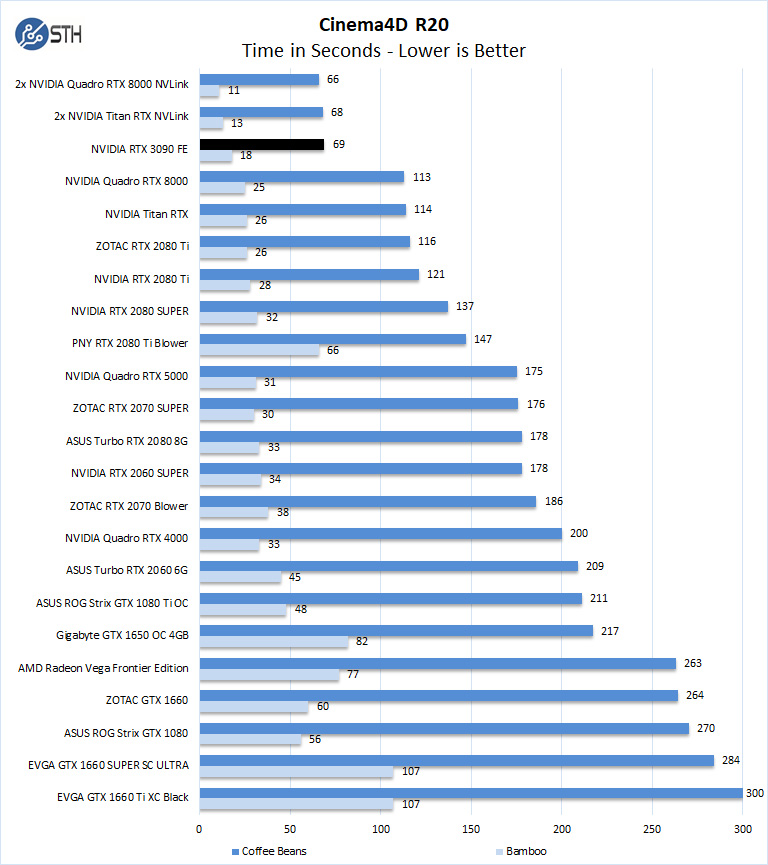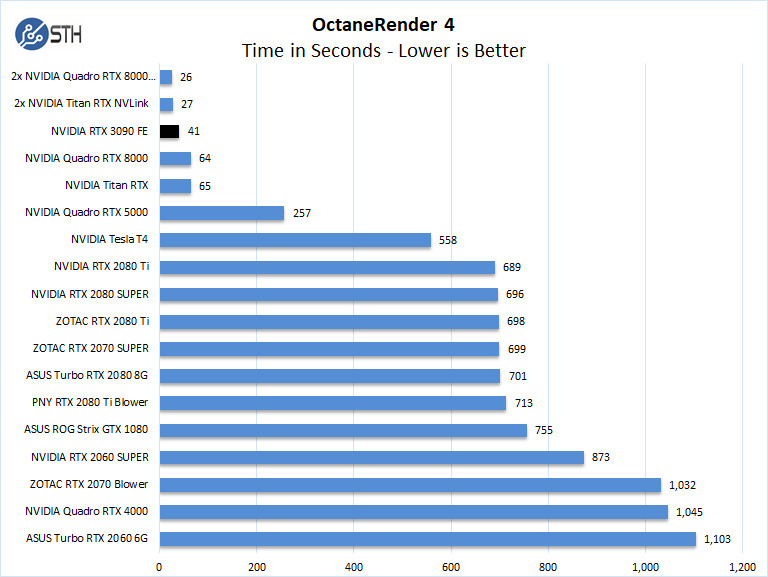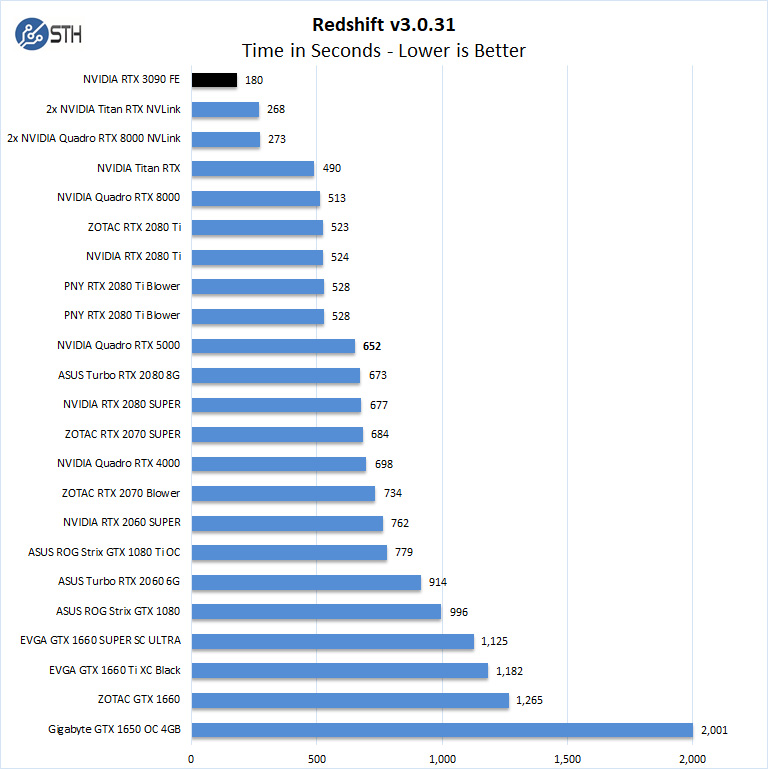NVIDIA RTX 3090 FE Rendering Related Benchmarks
Next, we wanted to get a sense of the rendering performance of the GeForce RTX 3090.
Arion v2.5
Arion Benchmark is a standalone render benchmark based on the commercially available Arion render software from RandomControl. The benchmark is GPU-accelerated using NVIDIA CUDA. However, it is unique in that it can run on both NVIDIA GPUs and CPUs.
Download the Arion Benchmark from here. First-time users will have to register to download the benchmark.

Like our first set of benchmarks, the GeForce RTX 3090 shows impressive single GPU results. This is a huge plus when one considers the costs of moving to more expensive dual GPU configurations in NVLink. We will see this trend in our rendering benchmarks.
MAXON Cinema4D 3D
ProRender is an OpenCL based GPU renderer that is available in MAXON’s Cinema4D 3D animation software. A fully functional 42-day trial version is available for downloaded from the MAXON website here. Note: Even after expiration, the trial can still be used to measure render times.

With a one-second difference, the GeForce RTX 3090 approaches Titan RTX and Quadro RTX 8000 in NVLink configurations.
OctaneRender 4
OctaneRender from Otoy is an unbiased GPU renderer using the CUDA API. The latest release, OctaneRender 4, introduces support for out of core geometry. Octane is available as a standalone rendering application, and a demo version is available for downloaded from the OTOY website here.

OctaneRender generates a very heavy load on GPUs. Here the GeForce RTX 3090 again approaches Titan RTX and Quadro RTX 8000 NVLink configurations.
Redshift
Redshift is a GPU-accelerated renderer with production-quality. A Demo version of this benchmark can be found here.

With Redshift, we have a new version of the Demo at v3.0.31 to take advantage of the latest NVIDIA RTX 3000 series of graphics cards. Here, the GeForce RTX 3090 takes the top spot with a blistering 180 seconds to finish. This result is over twice as fast as the Titan RTX!
Next, we will have 3DMark results before moving onto power consumption, thermals, and our final thoughts.




Are you using the Tensorflow 20.11 container for all the machine learning benchmarks? It contains cuDNN 8.0.4, while the already released cuDNN 8.0.5 delivers significant performance improvements for the RTX 3090.
Great fp64 performance..
It’s not great fp64. The 3090’s AIDA64 GPGPU score of 638 is less than 10% of the 6351 FLOPS my Radeon Pro VII pulls down. https://twitter.com/hubick/status/1324203898949652480
How did the NVlinked, Titan RTXs and Quadro RTX 8000s get better than 100% scaling in OctaneRender 4.0?
Chris Hubick
‘
Misha, as well known AMD shill, is being facetious – and this is a graphics card and not a compute card like the Ampere A100 – which trades the RT cores for FP64…
Would love to see this dataset run on a A100 for comparison, is that review coming as well or are those datasets not public?
Hi,
I LOVE the GeForce and Threadripper compute reviews (especially the youtube video reviews!)
However, for our work load, we really need to know how the hardware performs for double-precision memory-bound algorithms.
The best benchmark that matches our problems (computational physics) is the HPCG benchmark.
Would it be possible to add HPCG results for the reviews? (http://www.hpcg-benchmark.org/)
Also, for some other computational physicists, having the standard LinPack benchmark (for compute-bound algorithms) would be really nice to see as well (https://top500.org/project/linpack/)
– Ron